Snake venom is lethal, with up to 100,000 people dying yearly from snake bites.
Having established that humans and even animals alike are susceptible to snake venom, one thought-provoking question remains: are snakes immune to their own venom, or is it deadly to them?
Before answering that, though, there are some things to consider; this article will help shed light on the question.
Where does snake venom come from?
Contrary to common belief, snakes don’t have venom reserves in their jaws or fangs. Instead, they keep it in the alveoli, a gland.
The salivary glands on the back of their heads generate venom, which is then transferred to the alveolar gland, also known as the venom gland.
The venom is transferred from the alveoli to the snake’s fangs when it bites.
What is snake venom made up of?
Numerous hundred proteins make up snake venom, each having a somewhat distinct damaging impact on a victim’s body.
Even though they are of the same species, a snake’s poison may differ from another snake’s.
But generally speaking, snakes hurt us in one of two ways: by assaulting the neurological or circulatory systems (i.e., the blood).1
How do snakes come in contact with their venom?
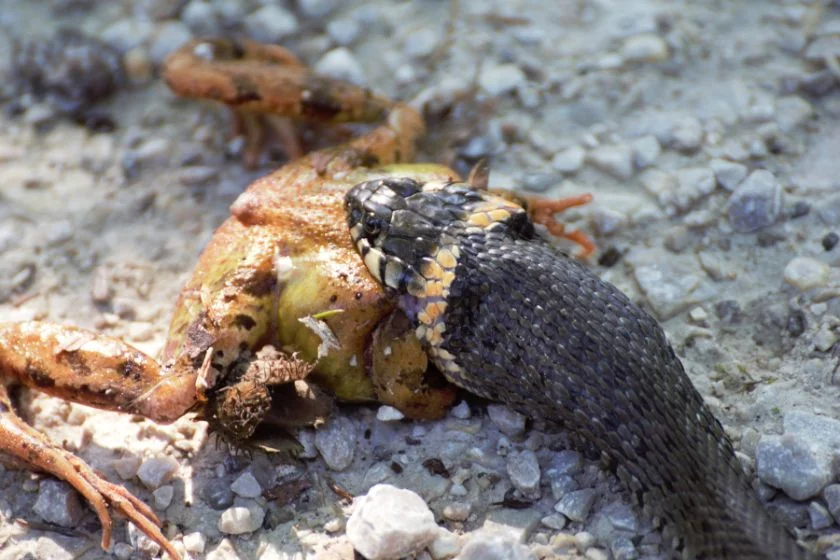
In most cases, snake venom does not always kill its prey; instead, it paralyzes its prey, so it doesn’t always result in their death.
This implies that their venom is usually still in the victim’s body when they eat their prey.
Are snakes immune to their own venom?

If you’re wondering why snakes don’t die after eating poisoned prey, it is because they have a special manner of digesting their prey, which involves their stomachs!
Snakes are immune to their own venom due to a combination of genetic mutations and protein inhibitors that neutralize the venom before it can cause harm.
One of the key genetic mutations that allow snakes to produce venom is the duplication and diversification of genes that code for venom proteins.
This allows snakes to produce and inject highly toxic venom into their prey without risking harm to themselves.
In addition to genetic mutations, snakes have protein inhibitors that neutralize the venom before it can cause damage.
These inhibitors, called venom-specific serine proteases, bind to the venom proteins and inactivate them.2
Furthermore, snakes have developed a unique immune system that can effectively clear and detoxify the venom.
They have a special class of immune cells called granular lymphocytes that can specifically recognize and neutralize venom proteins.
The combined effect of these genetic mutations, protein inhibitors, and specialized immune cells allows snakes to produce and handle their own venom without harm.
Are snakes immune to the venom of snakes of the same species?
Bites frequently occur between snakes of the same species, whether they occur during mating or fighting between rivals. For the species to survive, having resistance to its venom is essential.
While they do have some level of resistance, the resistance is not as high as the resistance to their own venom.
This is because the venom of different individuals of the same species can vary in composition and toxicity.
Therefore the resistance mechanisms that a snake has developed may not be effective against all variations of venom.
Are snakes immune to the venom of other species of snakes?
Snakes are not completely immune to the venoms of other species of snakes, but they do have some level of resistance.
This is because they have developed mechanisms to protect themselves from the venom of other species.
This includes developing resistance to certain venom components or producing proteins that neutralize the venom.
However, this resistance varies from one species of snake to another and from one individual to another.
Some snakes may have a higher level of resistance to the venom of other snakes, while others may be more susceptible.
For example, the venom of a pit viper, like a rattlesnake, can be deadly to other species.
Therefore, when two snake species encounter each other, they may use their venom as a defense mechanism.
Frequently Asked Questions (FAQs)
Are non-venomous snakes immune to snake bites?
No. Like other animals, non-venomous snakes are not immune to snake venom. Therefore, a bite from a venomous snake could affect a non-venomous snake.
Are snakes venomous or poisonous?
Snakes bite to inject their toxins, making them venomous. However, poisonous animals only unload toxins when one eats them. While most snakes are venomous, one poisonous snake we readily point at is the garter snake that absorbs and stores toxins from its prey.
Do snakes ever run out of venom?
Snakes can exhaust their venom after several consecutive bites. However, the number of times a snake can bite before it exhausts its venom depends on its species.
What animals are immune to snake venom?
Some animals are immune to snake toxins, including the California ground squirrel, hedgehog, domestic pig, and honey badger, with venom resistance unique to them.
The hedgehog has a blood-based anti-venom; the mongoose has cell coding to repel venom, and the honey badger has thick skin that prevents the fangs from reaching its blood vessels.
Wrap Up
In conclusion, snakes have evolved a unique immune system that allows them to produce and handle their own venom without harm.
This is accomplished through a combination of genetic mutations and protein inhibitors that neutralize the venom before it can cause damage.
Understanding the mechanisms behind snake immunity to the venom can provide insight into the development of new treatments for venomous snakebites.
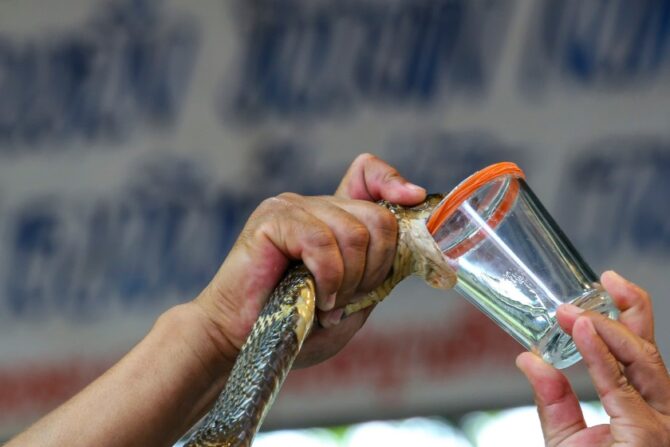
A snake bite does not mean the end for any said victim if handled quickly.
Anti-venoms, which have proven to be life-saving antidotes, are created by collecting venom from snakes and are very effective.
On that note, due to how expensive and scarce anti-venom is, it is always best to avoid areas where venomous snakes are known to inhabit or are spotted.
Overall, snakes are fascinating creatures with incredible abilities, and further research on this topic can help us to better understand the intricacies of evolution and the natural world.
Next up…
References & Notes
- Introduction to the Nervous System. U.S. Department of Health and Human Services.
- Miyagui, Camila, et al. 2013. Serine Proteases — Cloning, Expression and Potential Applications’. An Integrated View of the Molecular Recognition and Toxinology – From Analytical Procedures to Biomedical Applications, InTech.


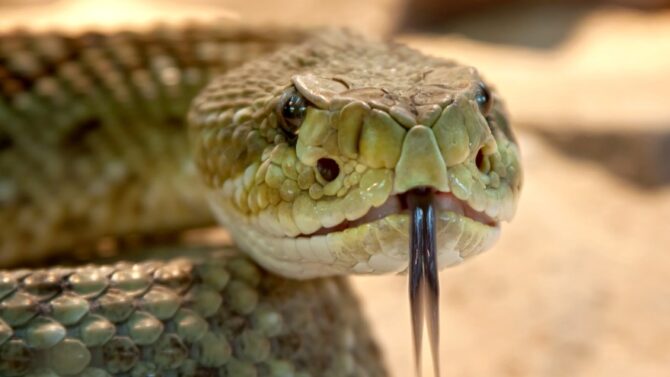
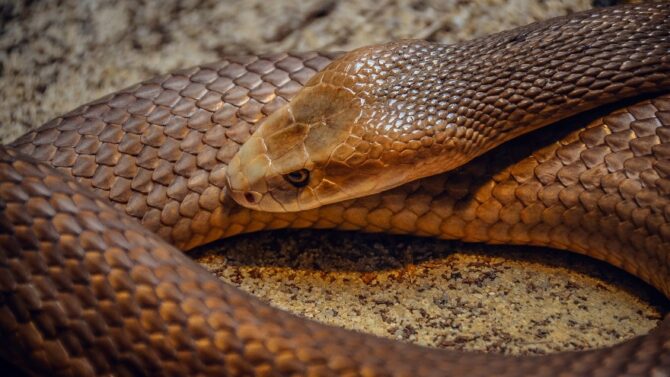
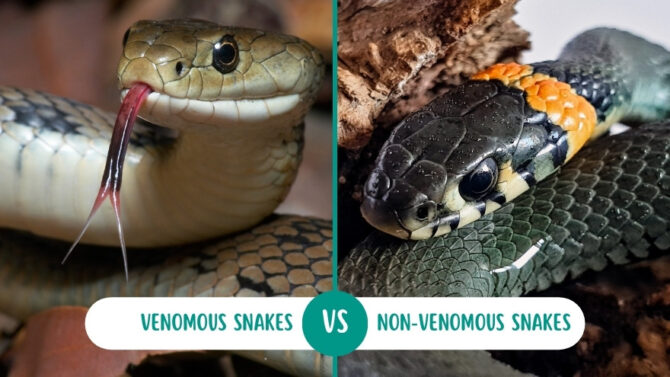

![How Often Do Corn Snakes Shed Their Skin [Answered]](https://animalvivid.com/wp-content/uploads/2022/11/How-Often-Do-Corn-Snakes-Shed-Their-Skin-Answered.jpg.webp)